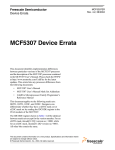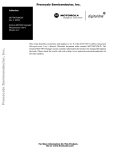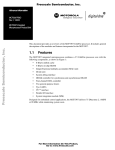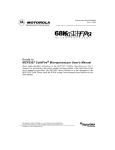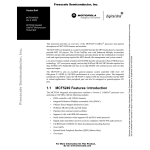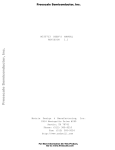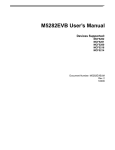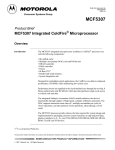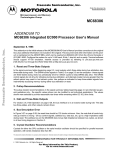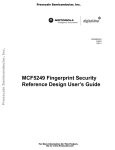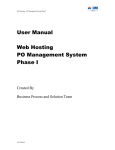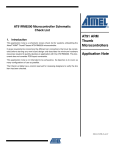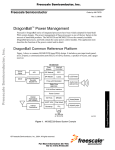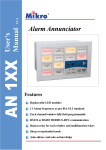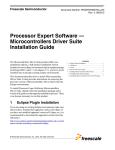Download AN2247: Interfacing the MCF5307 SDRAMC to an External Master
Transcript
Freescale Semiconductor Application Note AN2247/D Rev. 0, 1/2002 Freescale Semiconductor, Inc... Interfacing the MCF5307 SDRAMC to an External Master Melissa Hunter TECD Applications This application note discusses the issues involved in designing external logic that allows the ColdFire® processor’s on-chip SDRAM controller to work with external masters. Although this document specifically refers to the MCF5307, it can be used to design an external master-to-SDRAMC interface for the MCF5407 as well, since the SDRAMC modules are the same. This document assumes familiarity with the MCF5307 SDRAMC and working knowledge of the initialization sequence required for proper SDRAM operation. For the purposes of this application note, it is assumed that all SDRAM accesses are aligned and non-bursting. Refer to the MCF5307 User’s Manual (MCF5307UM/D) and Using the SDRAM Controller on the MCF5307 ColdFire Integrated Processor Application Note (AN1766/D) for more information. 1.1 Overview The block diagram in Figure 1 shows the connections between the MCF5307, PLD, SDRAM, and the external master. © Freescale Semiconductor, Inc., 2004. All rights reserved. For More Information On This Product, Go to: www.freescale.com Freescale Semiconductor, Inc. Overview MCF5307 SDRAM SRAS RAS SCAS CAS DRAMW WE SCKE (muxed) (linear) Address1 CMD/AP/A10 PLD Freescale Semiconductor, Inc... CLK BCLKO TA CLK Address1 Address1 TS or AS TS or AS R/W SIZ[1:0] R/W SIZ[1:0] BG BG BD BD BR BR Vcc Data[31:0] CKE Data[31:0] External Master Data[31:0] 1 RAS[1:0] CS CAS[3:0] DQM For this implementation, the MCF5307 and external master output a linear address, while the PLD outputs a muxed address to the SDRAM. Figure 1. Block Diagram Once the external master is granted control of the bus, it initiates an SDRAM access by asserting either TS or AS (only one signal can be used). The external master also needs to drive the linear address, data (if a write cycle), SIZ[1:0], and R/W. Once the assertion of TS or AS alerts the MCF5307 to the beginning of a new bus cycle, the processor latches the address, SIZ[1:0], and R/W signals to determine what type of bus cycle is starting. If the address hits in SDRAM space, the MCF5307 drives the SDRAM control signals (SRAS, SCAS, DRAMW, SCKE (CMD), RAS, and CAS). 2 Interfacing the MCF5307 SDRAMC to an External Master For More Information On This Product, Go to: www.freescale.com Freescale Semiconductor, Inc. SDRAM Overview The PLD’s primary responsibility is to detect SDRAM bus cycles and generate the correct muxed address to the SDRAM. This means that the PLD needs to distinguish between an SDRAM access and an SDRAM command, such as a refresh cycle. During read or write accesses the PLD needs to handle address muxing and TA generation, but during other SDRAM commands the PLD should just pass the SDRAM control signals generated by the MCF5307 through to the SDRAM. 1.2 SDRAM Overview Freescale Semiconductor, Inc... One of the main differences between synchronous and asynchronous DRAM is the use of commands to control the memory’s state machine. During every clock cycle, the SDRAM latches in a new command based on the encoding of the address and control lines. Table 1 lists all of the SDRAM commands that are used by the MCF5307 SDRAM controller and the encoding of the ColdFire SDRAM control signals for the associated command. . Table 1. SDRAM Commands Truth Table Command Description RAS SRAS SCAS R/W SCKE (CMD) ACTV Decode row address L1 L H2 H V3 MRS Mode register set L L L L L NOP No operation L H H H X4 PALL Precharge all L L H L H READ Read access L H L H L REF Auto refresh L L L H X WRITE Write access L H L L L 1 L = Low H = High 3 V = Valid 4 X = Don’t care 2 1.3 MCF5307 Signals Table 2 describes the MCF5307 signals used to interface to the SDRAM and external master. Table 2. MCF5307 Signals Signal Name Signal Description SDRAMC Signals SRAS Synchronous row address strobe. Indicates a valid row address can be latched by the SDRAM. Connects to SDRAM RAS input. SCAS Synchronous column address strobe. Indicates a valid column address can be latched by the SDRAM. Connects to SDRAM CAS input. DRAMW DRAM write. Indicates direction of data transfer for SDRAM cycles: • High indicates a read • Low indicates a write SCKE Synchronous clock enable. Enables SDRAM’s self-refresh mode. When external multiplexing is used, DCR[COC] allows the SCKE signal to provide command bit data for the SDRAM. Interfacing the MCF5307 SDRAMC to an External Master For More Information On This Product, Go to: www.freescale.com Freescale Semiconductor, Inc. The PLD Outputs Table 2. MCF5307 Signals (continued) Signal Name Signal Description RAS[1:0] Row address strobe. Used to select one of the two possible blocks of SDRAM that can be connected to the MCF5307. The RAS signals should be connected to the chip select input of the SDRAM. CAS[3:0] Column address strobe. For SDRAM, the CAS signals function as byte enables. They should be connected to the DQM pins of the SDRAM. Bus Signals BCLKO Bus clock output. System bus clock output from the MCF5307. Freescale Semiconductor, Inc... Address[31:0] 32-bit address bus. Data[31:0] 32-bit data bus. TS or AS Transfer start or address strobe. During external master bus cycles one of these signals must be asserted to alert the MCF5307 to the start of a new bus cycle. R/W Read/write. Indicates direction of data transfer: • High indicates a read • Low indicates a write SIZ Size. Encoded signals that indicate longword, byte, word, or line transfer. Bus Arbitration Signals BG Bus grant. Input to MCF5307 asserted to indicate that the MCF5307 can take mastership of the bus. BD Bus driven. Output from MCF5307 indicating that it is the current bus master and is driving the bus. BR Bus request. Output from MCF5307 to external master or arbiter to indicate that the MCF5307 requests bus mastership for one or more bus cycles. 1.4 The PLD Outputs This section discusses each of the PLD outputs and explains how they are generated. 1.4.1 RAS, CAS, and WE These signals are duplicates of the SRAS, SCAS, and DRAMW signals output by the MCF5307. The only difference between the outputs of the PLD and the MCF5307 is that the PLD adds additional delay on the signals. Care should be taken to ensure that this additional delay will not cause any timing conflicts. The EDGESEL module can help compensate for the additional delay on the control signals; see Section 11.4.2, “Using Edge Select (EDGESEL),” in the MCF5307 User’s Manual for more information. 1.4.2 Address The primary function of the PLD is to generate the muxed row and column addresses for the SDRAM. The SDRAM uses a two-phase address (a row and a column address) to access a single memory location. The row address is latched during an ACTV command, and the column address is latched during READ or WRITE commands (see Table 1 on page 3). Each is latched by the SDRAM during the appropriate address strobe (SRAS and SCAS). Any method can be used to generate the muxing solution, including the muxing algorithm already implemented by the MCF5307 SDRAMC. 4 Interfacing the MCF5307 SDRAMC to an External Master For More Information On This Product, Go to: www.freescale.com Freescale Semiconductor, Inc. 1.4.2.1 The PLD Outputs Muxing Example 1 In some cases it might be easiest to implement the same muxing scheme as used when the MCF5307 is handling the address muxing. For more information, refer to the address multiplexing tables in Section 11.4.4.1, “Address Multiplexing,” in the MCF5307 User’s Manual. For example, use the muxing shown in Table 3 when connecting to a 16-bit wide SDRAM port with 9 column addresses, 11 row addresses, and 2 bank selects. Freescale Semiconductor, Inc... Table 3. ColdFire SDRAM Muxing Algorithm Example 1 1.4.2.2 SDRAM Address Pin Linear Address Signal Driven during SRAS 1 Linear Address Signal Driven during SCAS1 A0 A16 A1 A1 A15 A2 A2 A14 A3 A3 A13 A4 A4 A12 A5 A5 A11 A6 A6 A10 A7 A7 A9 A8 A8 A18 A17 A9 A20 A19 A10 A21 SCKE (CMD) A11 A22 — BA0 A23 — BA1 A24 — The linear address signals listed correspond to the physical address pin on the MCF5307. Muxing Example 2 Using external logic to handle the address line muxing for all SDRAM bus cycles allows for any valid muxing scheme to be used. Since the muxing scheme used by the SDRAMC is somewhat complicated, a simpler muxing algorithm, such as that shown in Table 4, can be used instead. Table 4. Alternate SDRAM Muxing Algorithm SDRAM Address Pin Linear Address Signal Driven during SRAS 1 Linear Address Signal Driven during SCAS1 A0 A1 A13 A1 A2 A14 A2 A3 A15 A3 A4 A16 A4 A5 A17 A5 A6 A18 Interfacing the MCF5307 SDRAMC to an External Master For More Information On This Product, Go to: www.freescale.com Freescale Semiconductor, Inc. The PLD Outputs Freescale Semiconductor, Inc... Table 4. Alternate SDRAM Muxing Algorithm (continued) 1 1.4.3 SDRAM Address Pin Linear Address Signal Driven during SRAS 1 Linear Address Signal Driven during SCAS1 A6 A7 A19 A7 A8 A20 A8 A9 A21 A9 A10 A22 A10 A11 SCKE A11 A12 — BA0 A23 — BA1 A24 — The linear address signals listed correspond to the physical address pin on the MCF5307. CMD/AP/A10 The command (CMD) bit (also known as auto-precharge(AP) or A10 of the SDRAM) is a specialized address line input to the SDRAM. During a row address phase, this signal is used as a bit in the row address, but, at other times, it is used to indicate specific SDRAM commands to be processed. Setting the COC bit in the DRAM control register (DCR) allows the MCF5307 to drive the command data on the SCKE line instead of driving the command on one of the address lines. So, the data from the SCKE line should be output on the PLD’s CMD output most of the time, but during an SRAS strobe (ACTV) the output is an address signal. 1.4.4 Transfer Acknowledge The TA timing is not consistent for external master SDRAM accesses, so the PLD must be used to generate an external TA that can be routed to the external master (see device errata #23 in Errata to MCF5307 (document number: MCF5307ER/D) for more information). Consider 2 basic cases—writes and reads. For a write cycle, the data is latched by the SDRAM at the same time as the column address, as shown in Figure 2; however, the SDRAMC must execute a PALL to close the current memory page. Therefore, TA should be asserted during the PALL command. NOTE The signal names used in Figure 2 and Figure 3 are the MCF5307 signal names NOT the signal names used by the SDRAM. For example, the RAS signal in the timing diagram refers to the MCF5307 RAS lines which connect to the SDRAM chip selects. 6 Interfacing the MCF5307 SDRAMC to an External Master For More Information On This Product, Go to: www.freescale.com Freescale Semiconductor, Inc. The PLD Outputs Bus Cycle Terminated during PALL Command SDRAM Latches Data BCLKO TS Address Freescale Semiconductor, Inc... Data SRAS SCAS DRAMW RAS CAS TA ACTV NOP WRITE NOP PALL Figure 2. SDRAM Write Cycle Termination Timing During read cycles there is a delay between when the column address is latched and when the data becomes available known as CAS latency (given in bus clocks). So for read cycles, once the PLD detects the end of the column address phase, it then needs to wait the same number of clocks as the CAS latency before terminating the bus cycle as shown in Figure 3. Interfacing the MCF5307 SDRAMC to an External Master For More Information On This Product, Go to: www.freescale.com Freescale Semiconductor, Inc. The PLD Outputs Data Latched by SDRAM and Bus Cycle Terminated BCLKO TS Address Freescale Semiconductor, Inc... Data SRAS SCAS DRAMW RAS CAS TA ACTV NOP READ NOP PALL Figure 3. SDRAM Read Cycle Termination Timing 1.4.5 PLD Operation during SDRAM Commands During all commands, the PLD should drive the SRAS, SCAS, and DRAMW on the RAS, CAS, and WE outputs of the PLD. Table 5 describes the effect of each SDRAM command on PLD operation. 8 Interfacing the MCF5307 SDRAMC to an External Master For More Information On This Product, Go to: www.freescale.com Freescale Semiconductor, Inc. Programming the MCF5307 SDRAMC Table 5. PLD Operation During SDRAM Commands Freescale Semiconductor, Inc... Command 1.5 PLD Operation ACTV Row address strobe and bank activation. During the ACTV command the SDRAM latches the row address. The PLD should drive the row address for the selected muxing algorithm. MRS Mode register set command. Sets the mode register physically located on the SDRAM chip(s). The mode register controls some of the timing and mode options for the SDRAM including the CAS latency. This command is unique in that the data written to the mode register is latched from the address lines. This means that the data to be written to the mode register must be mapped onto the address lines. Refer to Section 11.5.5, “Mode Register Initialization,” in the MCF5307 User’s Manual for an example on how to determine the correct address to use during the mode register set command. NOP No operation. The PLD does not need to do anything. PALL Precharge all. Closes the current SDRAM page, so next access starts with an ACTV command. PLD needs to drive command data from the SCKE line onto A10 of the SDRAM. READ Read. The column address to be read is latched by SDRAM. PLD should drive the column address for the selected muxing algorithm and drive command data from SCKE line onto the SDRAM’s CMD pin. The READ command should also start the PLD counter responsible for generating the TA. REF Refresh. Periodic refresh is required to retain data stored in SDRAM. PLD should pass through SDRAM control signals. Programming the MCF5307 SDRAMC This application note is not intended to address the settings and procedures for programming the SDRAMC; however, it is useful to note that the DRAM control register (DCR) should be configured with the no address multiplexing (NAM) and command-on-SDRAM clock enable (COC) bits both set. The NAM bit turns off the MCF5307’s internal muxing capability so that all address muxing is handled by the PLD. The COC bit enables the SDRAMC to place the command bit information for the SDRAM on the SCKE line. The PLD drives the command data from SCKE onto the SDRAM’s A10 address line. Since the SCKE signal is used to provide the SDRAM’s command bit data, the self-refresh low-power mode is not available with this implementation. The CKE signal on the SDRAM should be tied high to disable the self-refresh mode. For more information on initializing the SDRAM see the SDRAM section of the MCF5307 User’s Manual. Interfacing the MCF5307 SDRAMC to an External Master For More Information On This Product, Go to: www.freescale.com Freescale Semiconductor, Inc. Freescale Semiconductor, Inc... Programming the MCF5307 SDRAMC 10 Interfacing the MCF5307 SDRAMC to an External Master For More Information On This Product, Go to: www.freescale.com Freescale Semiconductor, Inc. Freescale Semiconductor, Inc... Programming the MCF5307 SDRAMC Interfacing the MCF5307 SDRAMC to an External Master For More Information On This Product, Go to: www.freescale.com Freescale Semiconductor, Inc... Freescale Semiconductor, Inc. Home Page: www.freescale.com email: [email protected] USA/Europe or Locations Not Listed: Freescale Semiconductor Technical Information Center, CH370 1300 N. Alma School Road Chandler, Arizona 85224 (800) 521-6274 480-768-2130 [email protected] Europe, Middle East, and Africa: Freescale Halbleiter Deutschland GmbH Technical Information Center Schatzbogen 7 81829 Muenchen, Germany +44 1296 380 456 (English) +46 8 52200080 (English) +49 89 92103 559 (German) +33 1 69 35 48 48 (French) [email protected] Japan: Freescale Semiconductor Japan Ltd. Headquarters ARCO Tower 15F 1-8-1, Shimo-Meguro, Meguro-ku Tokyo 153-0064, Japan 0120 191014 +81 2666 8080 [email protected] Asia/Pacific: Freescale Semiconductor Hong Kong Ltd. Technical Information Center 2 Dai King Street Tai Po Industrial Estate, Tai Po, N.T., Hong Kong +800 2666 8080 [email protected] For Literature Requests Only: Freescale Semiconductor Literature Distribution Center P.O. Box 5405 Denver, Colorado 80217 (800) 441-2447 303-675-2140 Fax: 303-675-2150 LDCForFreescaleSemiconductor @hibbertgroup.com Information in this document is provided solely to enable system and software implementers to use Freescale Semiconductor products. There are no express or implied copyright licenses granted hereunder to design or fabricate any integrated circuits or integrated circuits based on the information in this document. Freescale Semiconductor reserves the right to make changes without further notice to any products herein. Freescale Semiconductor makes no warranty, representation or guarantee regarding the suitability of its products for any particular purpose, nor does Freescale Semiconductor assume any liability arising out of the application or use of any product or circuit, and specifically disclaims any and all liability, including without limitation consequential or incidental damages. “Typical” parameters which may be provided in Freescale Semiconductor data sheets and/or specifications can and do vary in different applications and actual performance may vary over time. All operating parameters, including “Typicals” must be validated for each customer application by customer’s technical experts. Freescale Semiconductor does not convey any license under its patent rights nor the rights of others. Freescale Semiconductor products are not designed, intended, or authorized for use as components in systems intended for surgical implant into the body, or other applications intended to support or sustain life, or for any other application in which the failure of the Freescale Semiconductor product could create a situation where personal injury or death may occur. Should Buyer purchase or use Freescale Semiconductor products for any such unintended or unauthorized application, Buyer shall indemnify and hold Freescale Semiconductor and its officers, employees, subsidiaries, affiliates, and distributors harmless against all claims, costs, damages, and expenses, and reasonable attorney fees arising out of, directly or indirectly, any claim of personal injury or death associated with such unintended or unauthorized use, even if such claim alleges that Freescale Semiconductor was negligent regarding the design or manufacture of the part. AN2247/D For More Information On This Product, Go to: www.freescale.com












